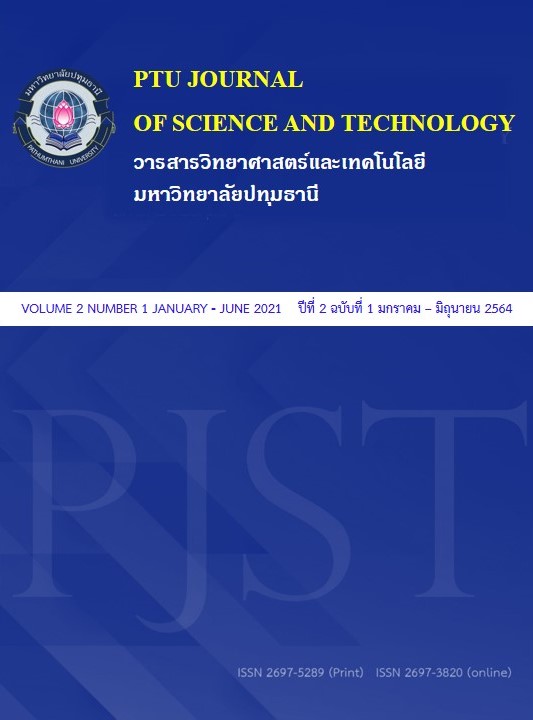Statistics: Significance, Power, Sample Size & Effect Size
Main Article Content
บทคัดย่อ
วิชาสถิติที่มีทั้งคำนิยาม ข้อมูล ตัวเลข สัญลักษณ์ สูตร และรูปภาพ เป็นสิ่งทำให้วิชาสถิติเป็นวิชาที่ดูยากและทำให้ผู้เรียนมีทัศนคติเชิงลบปิดกั้นที่จะศึกษา ทั้ง ๆ ที่วิชานี้เป็นส่วนสำคัญของการวิจัยต่าง ๆ การวิเคราะห์อำนาจทดสอบ ซึ่งเป็นความเชื่อมโยงกันของ ระดับนัยสำคัญ อำนาจทดสอบ ขนาดอิทธิพล และขนาดตัวอย่าง การจะเข้าใจการวิเคราะห์อำนาจทดสอบควรเริ่มต้นความเข้าในสถิติพื้นฐาน ข้อมูล การแจกแจงความถี่ ร้อยละ การวัดแนวโน้มเข้าสู่ส่วนกลาง ความน่าจะเป็น การแปลงเป็นค่ามาตรฐาน การกระจายของการสุ่มตัวอย่าง และการทดสอบสมมติฐาน ตามลำดับ บทความนี้ได้ใช้การบรรยาย การยกตัวอย่าง สัญลักษณ์และรูปภาพเท่าที่จำเป็น เพื่อให้ผู้เรียนหรือนักวิจัยเข้าใจและนำไปใช้งานได้อย่างเหมาะสมต่อไป
Article Details
ความคิดเห็นและข้อเสนอแนะใดๆ ที่นำเสนอในบทความเป็นของผู้เขียนแต่เพียงผู้เดียว โดยบรรณาธิการ กองบรรณาธิการ และคณะกรรมการวารสารวิทยาศาสตร์และเทคโนโลยี มหาวิทยาลัยปทุมธานี ไม่ได้มีส่วนเกี่ยวข้องแต่อย่างใด มหาวิทยาลัย บรรณาธิการ และกองบรรณาธิการจะไม่รับผิดชอบต่อข้อผิดพลาดหรือผลที่เกิดจากการใช้ข้อมูลที่ปรากฏในวารสารฉบับนี้
เอกสารอ้างอิง
อาฟีฟี ลาเต๊ะ. (2561). ทัศนคติต่อรายวิชาสถิติของกลุ่มผู้เรียนระดับพื้นฐาน ระดับกลาง และระดับใช้งาน. Veridian E-Journal,Silpakorn University ฉบับภาษาไทย สาขามนุษยศาสตร์สังคมศาสตร์ และศิลปะ. ปีที่ 11 ฉบับที่ 1 เดือนมกราคม –เมษายน 2561 : หน้า 2591-2604.
Annenberg Learner. [Online]. (2020). Against All Odds: Inside Statistics: What Is Statistics? Retrieved from https://www.learner.org/series/against-all-odds-ins ide-statistics/what-is-statistics/
Araujo, P., Froyland, L. (2007), Statistical power and analytical quantification. Journal of Chromatography B. Vol. 847: p. 305-308.
Bluman, A.G. (1998). Elementary Statistics. 3rd ed. Boston: WCB McGraw-Hill.
Buchner, A., Erdfelder, E., Faul, F., Lang, A.-G. (2020, October 15). G*Power3.1 manual October 15, 2020. Retrieved from https://www.psychologie. hhu.de/fileadmin/redaktion/Fakultaeten/MathematischNaturwissenschaf tliche _Fakultaet/Psychologie/AAP/gpower/GPowerMa nual.pdf
Cohen J. (1988). Statistical power analysis for the behavioral sciences. 2nd ed. Hillsdale, NJ: Lawrence Erlbaum Associates, Publishers; 1988.
Groebner, D.F., Shannon, P.W., Fry, P.C., Smith, K.D. (2001). Business Statistics A Decision-Making Approach. New Jersey: Prentice-Hall.
Hingle, D.E., Wiersma, W., Jurs, S.G. (1979). Applied Statistics for the Behavioral Sciences. Chicago: Rand McNally College.
Krejcie, R. V., and Morgan, D. W. (1970). Determining Sample Size for Research Activi- ties. Educational and Psychological Mea- surement. Vol. 30: p. 607 – 610.
McLeod, S. [Online]. (2019). SimplyPsychology. What does effect size tell you? Retrieved from https://www.simplypsychology.org/effect-size.html
Mysiak, K. [Online]. (2020, Aug 29). Towards Data Science. The Relationship between Significance, Power, Sample Size & Effect Size. Retrieved from https://towardsdatascience.com/the-relationship-between-significance-power-sample-size-effect-size-899fcf95a76d
Mustafa, R.Y. (1996). The Challenge of Teaching Statistics to Non-Specialists. Journal of Statistics Education. Vol. 4 (No. 1): p. 1-10. DOI: 10.1080/10691898.1996.11910504
Prajapati, B., Dunne, M., Armstrong, R. [Online]. (2009, November). Sample size estimation and statistical power analyses. Ot Peer Reviewed. 2009, November. Retrieved from https://www.researchgate.net/publication/2653 99772
Quinn, G.P., Keough, M.J. (2002). Experimental Design and Data Analysis for Biologists (1st ed.). Cambridge, UK: Cambridge University Press. p. 46–69.
Ruggeri, K., Dempster, M., Hanna, D., Cleary, C. (2008). Experiences and expectations: The real reason nobody likes stats. Psychology Teaching Review. Vol.14 (No.2): p. 75–83.
Slootmaeckers, K., Kerremans, B., Adriaensen, J. (2014). Too Afraid to Learn: Attitudes towards Statistics as a Barrier to Learning Statistics and to Acquiring Quantitative Skills. Politics. Vol.34 (No. 2): p.191–200. doi:10.1111/1467-9256.12042
Yamane, T. (1970). Statistics: an introductory analysis. New York: Harper and Row.


